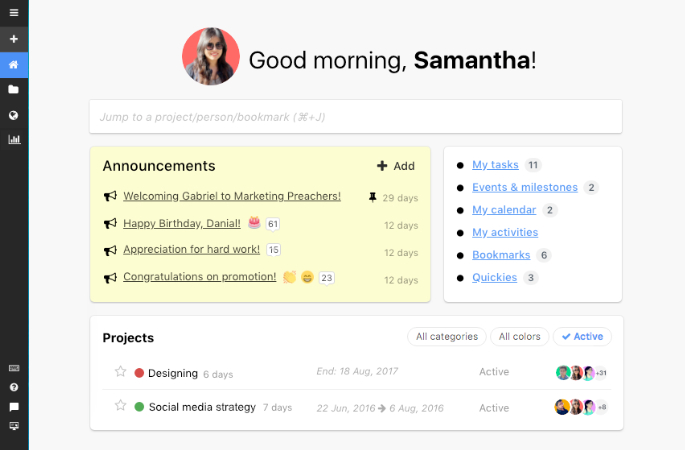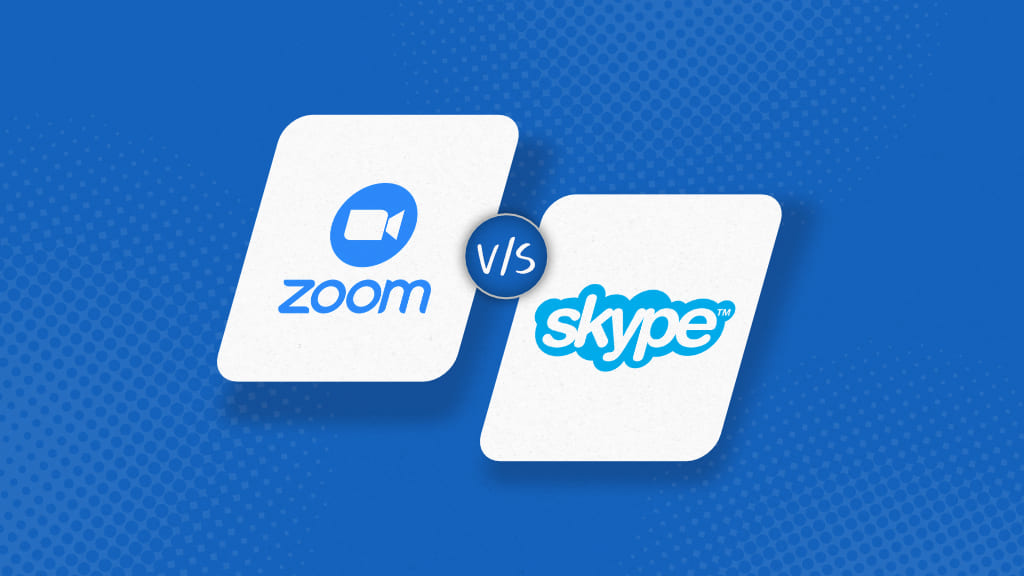Zoom and Skype have always been among the top choices for businesses looking to ramp-up their team communication.
However, making a choice between these two leading enterprise-level communication software is never easy.
In 2020, soon after the COVID-19 outbreak, many businesses have decided to revise their communication strategy by adding a team communication tool, and guess what? Most of them ended up being confused while making the final choice between Zoom and Skype. This is the reason why Zoom vs Skype has become one of the most trending debates.
I know you are here because you are also in the dilemma of choosing between Zoom and Skype as these two have become the face of modern-day team collaboration and virtual communication.
Both these tools have many features that are similar but not identical. It means that you have to observe Skype and Zoom closely to find out which is best according to your business’s requirements.
But don’t worry, there’s no need to do all the research from scratch as I have already done it for you. The only thing you are supposed to do right now is to read this article till the end.
Let’s get started!
Zoom vs Skype: Quick Overview
What is Zoom?
Zoom is a cloud-based communication app that allows teams to stay connected. Users can communicate with their peers using online chat, video conferencing, etc. It promotes collaboration among team members and helps them to boost teamwork as well as overall productivity. The app is easy to use and provides a frictionless environment for professionals to communicate and share information securely.
What is Skype?
Skype is a telecommunication app, which is currently owned and managed by none other than Microsoft. The platform gives users the flexibility to connect with team members over text messages, voice calls, and video calls. The user base of Skype is quite large and it has been available in the market for more than 15 years, which testifies its credibility.
Looking for a tool that gives you full control of your teams and tasks? Try ProofHub!
Zoom vs Skype: The Battle Begins
Let’s compare both the tools in terms of the features that they offer to the users.
1. User Interface
Zoom
Zoom comes with a simple yet intuitive user interface that is quite easy to understand. You will be able to adapt to its functionality in no time as its learning curve is short. You can start a meeting immediately with your teammates or schedule it for later without any hassle. You do not need any type of professional help to explore the features within the Zoom app.
Skype
The minimalistic and clean interface of Skype makes it a no-brainer for anyone. Hosting meetings, sending text messages, and making audio calls are just a few clicks away. You can navigate the app comfortably as all the elements including menus and action buttons are plain and easy to notice.
2. Conferencing Capabilities
Zoom
Zoom is designed to support high-quality audio and video calls along with screen sharing. You can invite your team members to join a video conferencing call or a group audio call. While on a video call, you can start sharing your screen and deliver presentations in an interesting manner. Additionally, as the host of a meeting, you get the authority to mute all the participants of a meeting and can also control their screens.
Bandwidth Requirements (Recommended):
- Audio Calling – 60-80 Kbps (down)
- Screen Sharing – 50 – 150 Kbps (down)
- Video Calling (1:1) (HD-720p) – 1.5 Mbps/1.5Mbps (up/down)
- Group Video Calling (HD-720p) – 1.5 Mbps/1.5Mbps (up/down)
Skype
Skype also offers several web conferencing features to make team meetings productive and successful. To be precise, Skype offers 4 types of conferencing for your team, namely web conferencing (screen sharing), audio and video conferencing, dial-in conferencing, and instant messaging. Just like Zoom, Skype also allows you to record your calls and meetings in a cloud storage space that you can access anytime.
Bandwidth Requirements (Recommended):
- Audio Calling – 100/100 Kbps (up/down)
- Screen Sharing – 300/300 Kbps (up/down)
- Video Calling (1:1) (HD-720p) – 1.5 Mbps/1.5Mbps (up/down)
- Group Video Calling (7+ people) – 8 Mbps/1.5Mbps (up/down)
3. Number of Participants
Zoom
The participant limit is among the most important parameters of a team communication application. For Zoom, the maximum participant limit is capped at a value of 100. However, you have the option to increase the participant limit with large meeting add-ons that are available at extra costs.
Skype
Compared to Zoom, Skype offers a participant limit of 50 in its basic version, which is free. If you want to invite more than 50 people on Skype for meetings, then you need to buy a paid subscription of Microsoft Teams. The maximum number of participants that can be a part of the meeting is set at 250.
4. Security and Privacy
Zoom
Zoom claims to employ industry-leading security standards when it comes to user privacy and data. However, lately, the app users have encountered security issues that are not good at all. Nonetheless, Zoom uses a 356-bit TLS and AES-256 encryption to protect all your communication and content data shared through the app.
Skype
All the messages, video & audio calls, and file transfers on Skype are secured using data encryption. It also uses two types of encryption: TLS (transport-level security), and AES (Advanced Encryption Standard) to safeguard all the data and sensitive information against theft.
5. Supported Devices
Zoom
You can use Zoom on all major devices, including PCs, laptops, and smartphones. Zoom has developed its app for all the popular platforms like Windows, Mac, Android, and iOS. The extensive list of supported devices and platforms makes it possible to connect with your teammates conveniently from anywhere in the world.
Skype
Skype is also available across a wide array of platforms including, Windows, Mac, Linux iOS, Android. You can install the Skype app on your device to get started with taking your team communication to the next level.
6. Suitable for Businesses
Zoom
Zoom is scalable, which means that it can meet the needs of businesses of all sizes. The app offers different subscription plans that businesses can choose from according to their requirements.
Skype
Small, medium, and large businesses can use Skype to keep their teams to stay connected. However, apart from being an apt communication app for businesses, Skype also makes a great choice for individuals and freelancers.
7. Available Languages
Zoom
Zoom app is available in several popular languages, including English, French, German, Japanese, and Spanish. Moreover, some less popular languages like Korean, Portuguese, and Vietnamese are supported on Zoom, which is great when you have a team of remote employees working from different locations.
Skype
As compared to Zoom, the number of supported languages on Skype is much higher. Arabic, Chineses, English (UK, US), French, Greek, Hindi, Indonesian, Italian, Polish, Turkish are some of the languages that are available on Skype. It’s quite easy to choose your native language to use the app with relative ease.
8. Pricing
Zoom
While opting for Zoom as your team communication app, you will have to make a choice among the 4 pricing plans that are:
Basic Plan – Free
Pro Plan – $14.99/month/host (Upto 9 hosts per account)
Business Plan – $19.99/month/host (For more than 10 hosts)
Enterprise Plan – $19.99/month/host (For more than 100 hosts)
Skype
Skype also comes with a free basic plan, which allows you to chat, make voice calls, and join video conferences with your colleagues. There are no other plans available for Skype but you can opt for its subscriptions that are basically calling plans. With a Skype calling plan, you will be able to make local and international calls to landlines and mobiles directly from your Skype account.
Other than the regular subscriptions, Skype is also available with the Microsoft 365 plans. By opting for a Microsoft 365 plan, you will get access to the premium apps offered by Microsoft such as Word, Excel, PowerPoint, Outlook, Access, and Publisher. Currently, there are two Microsoft 365 plans that offer 60 minutes per month for calling on mobile phones and landlines using Skype:
Microsoft 365 Personal – $6.99 per user per month
Microsoft 365 Family – $9.99 per month (for up to 6 users)
Earlier there used to be Skype for Business, which is now replaced by Microsoft Teams as the professional online meeting solution for organizations. Microsoft Teams has four different pricing plans that vary in terms of features offered to the users:
Microsoft Teams – Free
Microsoft 365 Business Basic – $5.00 per user per month
Microsoft 365 Business Standard – $12.50 per user per month
Office 365 E3 – $20.00 per user per month
Want to manage your tasks and teams effortlessly? Switch to ProofHub!
Skype vs Zoom: Pros, Cons, Reviews
Skype
Pros
- Easy to use and affordable: you get to access most features without the need of paying any money
- Its robust service ensures a great calling experience
- Whiteboard, poll, and Q&A feature for better team collaboration and engagement
- International calling at affordable rates
Also read: Seven Of The Best Zoom Alternatives You Never Knew Existed
Cons
- Support is not good considering it is a Microsoft product
- Technical issues and outage are common
Customer Ratings
TrustRadius – 7.9 / 10
PCMag – 4.5 / 5
G2 – 4.3 / 5
Zoom
Pros
- Offers excellent user experience
- Responsive customer support over online chat, phone calls
- Supports integrations with several third-party applications like Google Drive, Dropbox, Salesforce, and Google Calendar
Cons
- Privacy and security have become a major concern since many meetings on Zoom got hacked
- Video quality is extremely poor when using a slow internet connection
Customer Ratings
- TrustRadius – 8.9 / 10
- PCMag – 4.5 / 5
- G2 – 4.5 / 5
Skype vs Zoom: What’s Missing in Both the Software?
No doubt, Skype and Zoom are among the best communication software that professionals use to collaborate with their teams and other individuals.
But as we know, communication is not the only thing that decides the success of the business. There are other things too, such as managing resources, breaking a project into several tasks so that it becomes easy to delegate work to team members, keeping track of the project progress, and so on.
It would not be valid to say that Skype and Zoom should have features that make it easy to manage all the project work. However, what’s the point of using advanced tools for communication and not for managing work?
After all, communication happens in a team because there is work that requires people to collaborate and be on the same page.
If you believe that using communication software like Skype or Zoom will help your team to be at its best, you need to think again. Here are some of the key activities for managing a project effectively that you can’t do using Skype or Zoom:
- Task management
- Team management
- File & documents management
- Tracking project progress and ensuring timely delivery
- See how each task fits in the overall timeline of the project
- Proof files and give feedback on work in real-time
- Create detailed reports to discuss project progress with clients, stakeholders, etc. and make any necessary changes to the project plan
“Bring your teams, tasks and communications under one roof. Start using ProofHub.”
ProofHub: A Project Management Tool That You Need Alongside Any Video Conferencing Software

It doesn’t matter whether you are using Zoom, Skype, or any other video conferencing software, it’s good to have project management software like ProofHub on your side.
ProofHub gives you the ability to get ultimate control over projects, teams, and clients. It comes with all the essential tools that you need to manage your team and complete projects on time. Additionally, the software also comes loaded with various team collaboration features that make it possible for team members to stay in touch with one another.
The combination of ProofHub and a video conferencing software will help you to be in a better position as a team leader or project manager. You will be able to connect with your team members through virtual meetings and at the same time, you can stay on top of all your project work.
ProofHub’s Features That’ll Put You in Advantageous Position
- Custom Workflows and Kanban Boards
Kanban boards make it easy to streamline work by defining all the stages of the project. Create tasks as cards, add task details, create subtasks, select assignees, mark progress in percentage, and add comments directly on a task. You can also attach files with a task and add labels to clearly define its priority level. The best thing about managing tasks using a Kanban board is that you can see tasks moving through different stages of the workflow.
Gantt charts in ProofHub provide you the timeline view of your project and it becomes convenient to modify schedules as work changes and deadlines shift. You can do a lot of other things using Gantt charts such as associate milestones with tasks, set task dependencies, and highlight critical paths. It is also possible to see the progress of each task along with the overall project progress.
Creating detailed project reports is just a click away with ProofHub. You can use project reports to visualize different aspects of your project and assess if everything is going according to the project plan. The burn-up charts let you get a clear idea of the work that has been completed against the total amount of work. Additionally, it is possible to customize project reports by picking parameters of your choice and highlight specific data of your choice.
With in-built timers and timesheets, you can track the time spent by a team member working on a particular task and access time data anytime. ProofHub also gives you the flexibility to create time reports for team members and projects. Timesheets and time reports come handy for effective time management and are useful for creating payroll, client billing, etc.
ProofHub offers cloud storage space that you can use to store and organize all your project files at a single place. You can easily upload files from your computer or third-party online file storage services like Google Drive and Dropbox. Attach files directly to your tasks and share files with your colleagues.
Online proofing is among the best features that make ProofHub an exceptional choice for team collaboration. You can review task files, proof them, add comments as feedback. Also, by using markup tools, you can annotate files and highlight specific regions of a file that need modifications.
- In-built Chat
Send instant text messages to colleagues and exchange information in real-time with ProofHub’s chat tool. Use emojis to express yourself better and say more in fewer words. Also, you can exchange files directly by attaching them in chats.
Simple Pricing
For information on our pricing plans, kindly visit our pricing page.
Manage your projects and teams effectively. Start using ProofHub, today!
Conclusion
As you can see, the right combination of ProofHub and any of these two communication tools can be the best thing you can do to put your team in a winning position. So, go ahead and make your choice.
All the best!

